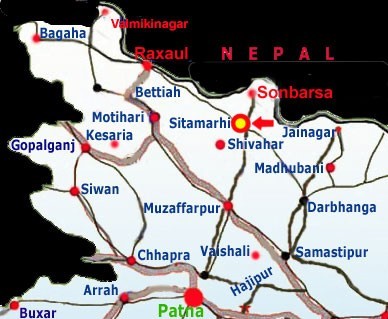Introduction

Sitamarhi is said to be the birthplace of Hindu goddess Sita, also revered as Janaki. The legend has it that the King of Janakpur (in Nepal, 60 km from here), ploughed the land here to get rid of a devastating drought, and it was in the course of the ploughing that he stumbled upon an earthen pot out of which Sita emerged. Hence, the place came to be known as Sitamarhi.
Places
of Interest
WHAT TO LOOK FOR
One can visit the famous Janaki, Shiva and Parvati tem ples at
Haleshwar Sthan, seven km from Sitamarhi, the dis- trict HQ town. Devotees as
well as tourists visit these temples and the latter go on to see the famous
Janakpur Dham in Nepal. The two cattle fairs – one on Navami during Navaratra
in September-October and the other on ‘Vivah Panchami’ in the winter are held
annually and attract thousands of visitors.HOW TO REACH
By Air:
Nearest Airport
Janakpur Dham, 60 km north; Patna, 150 km south.
By Rail:
Nearest railhead
Sitamarhi is situated 60 km north of Muzaffarpur and 70 km away from
Darbhanga. It is well connected with road and is also on the railway map.
By Road:
Connected by good roads with all Indian cities.
Where to Stay:
Private Hotels, Rest houses and Dharmshalas at Sitamarhi.Hotel Sitayan,
STD Code: 06226, Phone: 250605
Hotel Kishore, Phone: 06226-253288
Hotel Raj Kumar, Phone: 06226-250347
Local Transport:
Auto rickshaws, Cycle-rickshaws, tangas.
In Emergency, Contact, STD Code: 06226
District Magistrate: 250515 (Res), 250439 (Off)
Superintendent of Police: 250421 (Res), 250526 (Off)
Medical Emergencies,Contact, STD Code: 06226
Dr. R.A.Sharma: 250499
Dr. Sita Ram Singh: 251330
Dr. Sanjay Singh: 254700
Dr. Renu Chatterjee: 254650
Tourist Season:
October to March.
Clothing:
Light cotton in summer and woolen in winter (specially during November to
January).